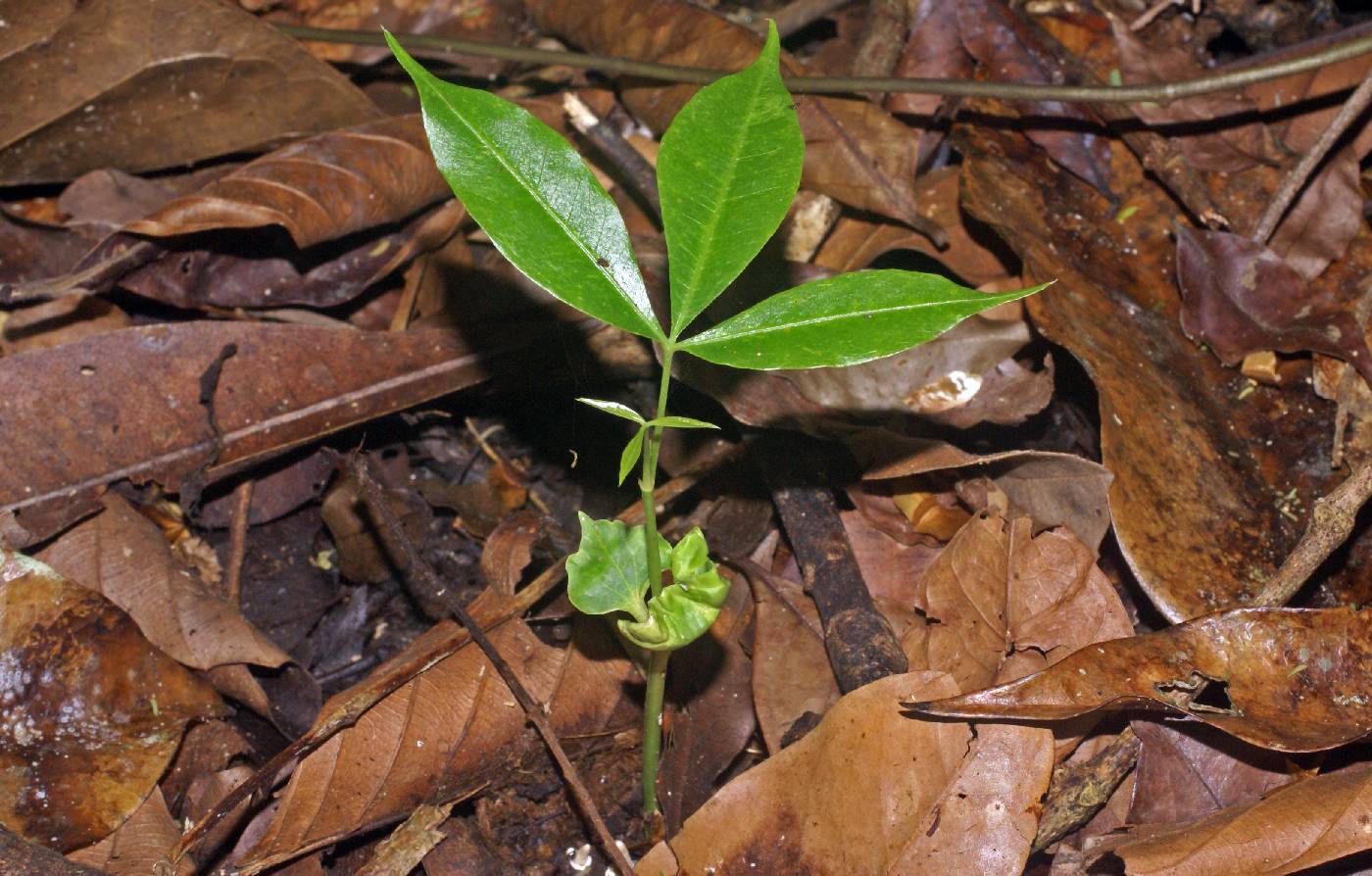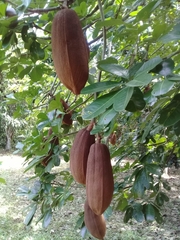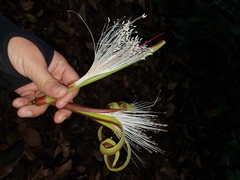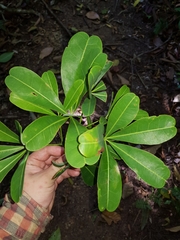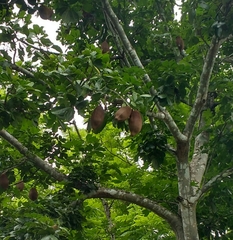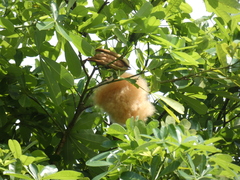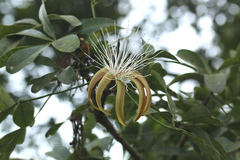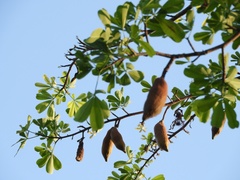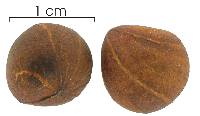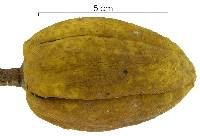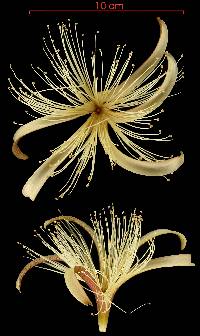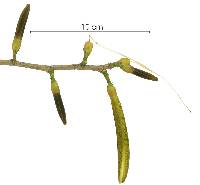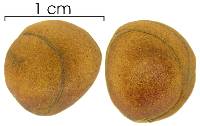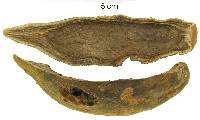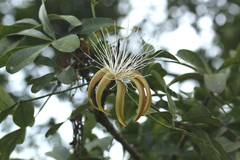

|
|
|
|
Family: Bombacaceae
ceibo nuno, more...yuco de monte
[Bombacopsis sessilis (Benth.) Pittier, morePochota sessilis (Benth.) W. D. Stevens] |
Description: A tall forest tree with a straight and cylindrical trunk. Large individuals have flat, thin buttresses at the base. The bark is yellowish, with vertical fissures evident, never with spines. Leaves are alternate, palmately-compound, with 4-9 leaflets that do not have teeth. Reproduction: Many trees lose all or most leaves during the dry season. Flowers early in the dry season, prior to leaf loss; fruits throughout the wet season. See LK pochqu Pachira quinata, LK2 which has essentially identical flowers and fruits. Distribution: Widespread from dry to wet sites of the Canal area, but usually rare; however, there are occasionally large groups of individuals. Saplings mostly restricted to forest clearings or open areas, and not seen very often. Large trees are seen along roads occasionally throughout the area. Similar Species: See LK pochqu Pachira quinata LK2 for a discussion of the 5 large and similar Bombacaceae. P. sessilis never has spines, and the leaflets lack teeth. Adults may be confused with medium-sized LK ceibpe Ceiba, LK2 which has fissured bark and similar buttresses, but Ceiba has narrower leaflets and gray, not yellow, bark. LK pochaq Pachira aquatica LK2 is more similar overall, but only grows in swamps or the high mountains in the area. Pachira sessilis is still better known by its old Latin name, Bombacopsis sessilis, or by Pochota sessilis. Uses: Surprisingly, unlike its relative the LK pochqu cedro espino, LK2 this species' timber is soft and has no value except perhaps for paper pulp. Descripción: Árbol de 20 a 35 m de alto. Tronco con raíces tablares pequeñas y delgadas en la base. Corteza exterior gris y exfoliante en láminas pequeñas. Hojas digitadas y alternas, con 4-9 folíolos, de 4-18 x 2-6 cm, obovados, con ápice emarginado o redondeado, bordes enteros y base decurrente. Pecíolo de 3-12 cm de largo y pulvinado en la base. Estípulas deciduas. Flores blancas con estambres numerosos. Filamentos de los estambres blancos, rosados o lilas. Frutos en cápsulas elongadas, de 8-14 cm de largo, verdes, tornándose rojizos y dehiscentes en cinco valvas al madurar. Semillas envueltas en una capa de pelos algodonosos. Datos Ecológicos: La especie crece a bajas y medianas elevaciones, en lugares húmedos o muy húmedos. En Panamá se encuentra en las provincias de Bocas del toro, Chiriquí, Coclé, Colón, Darién, Panamá, Veraguas y la comarca de Guna Yala. Puede crecer en terrenos rocosos cercanos a la costa. Deja caer sus hojas durante la estación seca, pero las repone a inicios de la estación lluviosa. Florece y fructifica de diciembre a octubre. Las flores son visitadas por abejas, aves y murciélagos. Las semillas son dispersadas por el viento. Especies Parecidas: A menudo se confunde con LK pochaq Pachira aquatica LK2 , pero en P. aquatica el fruto es de mayor tamaño y las semillas están rodeadas de una pulpa blanca, y en P. sessilis las semillas se encuentran rodeadas de pelos algodonosos. Usos: La madera es empleada para postes de cercas y en la elaboración de pulpa para papel. Los pelos algodonosos del fruto se usan para rellenar almohadas y colchones. Deciduous tree, 15-30 m tall, mostly 20-65 cm dbh; trunk unarmed, with greenish bark, with narrow plank buttresses to 1.5 in high; outer bark thin., grayish, with many vertical rows of lenticels, flaking; inner bark tan, thick, with irregular dark spots near periphery; branches at +/- regular intervals, self-pruning, the lowermost branches deciduous; branchlets roughened with lenticels and old petiolar bases. Leaves palmately compound, glabrous; stipules lanceolate; petioles +/- equaling leaflets, enlarged at both ends; blades (4) 5-7 (9), +/- narrowly obovate, emarginate at apex, 4-18 cm long, 1.5-6.5 cm wide. Flowers showy, white to pink, terminal on short lateral branches, solitary or as many as 5 on a branch, appearing before or after leaves fall, 13-24 cm long; pedicels 5-18 (32) mm long; calyx tubular, truncate or weakly lobed, about 1 cm long and 1 cm wide; petals 5, stellate outside, imbricate in bud, drying greenish, generally not markedly striped, and darker than B. quinata; stamens ca 250, fused into a column ca 8 cm long, the free part of filaments ca 6 cm long; anthers horseshoe-shaped, dehiscing by straightening, less than 2 mm long, shedding some pollen in bud; style bright red; stigma of 5 sharp lobes, pubescent inside. Capsules oblong, somewhat more elongate than B. quinata, the valves 5, woody, yellow-brown when fresh, opening to expose pale, often brownish kapok and seeds; seeds numerous, medium-sized, to 1 cm. Croat 8654, 129 76. Frequent in the forest, especially in the younger forest. Flowers from December to February. The fruits mature from March, persisting to October. Trees are bare for a short time in the dry season. Costa Rica and Panama; cultivated in Cuba and Jamaica. In Panama, known from tropical moist forest in the Canal Zone, Veraguas, and Panama, from tropical dry forest in Coclé and Panama, from premontane moist forest in the Canal Zone, Veraguas, and Panama, from premontane wet forest in Chiriqui and Panama, and from tropical wet forest in Colon. |

